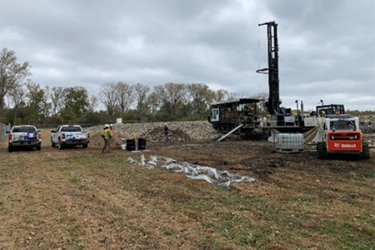EPA Researchers Update Tool To Support Contaminated Groundwater Cleanup At A Superfund Site In Kansas City
By U.S. EPA

From the 1960s to 1980s, chemical storage and disposal operations at the Conservation Chemical Company site, a 6-acre area in Kansas City, Missouri, contaminated soils and groundwater. Groundwater, which is the water found below the Earth’s surface within the cracks and crevices of soil, sand, and rock, can be particularly challenging to treat. Addressing these challenges involves many experts and can require innovative solutions to improve treatment methods and help clean up contaminated sites.
In 1987, the Conservation Chemical Company site was capped using dense clay and a vegetated cover to reduce the rate of infiltration into the subsurface and to reduce the risk to groundwater. In addition to capping the site, a groundwater extraction and treatment system was built that captures the water for above-ground treatment. However, this treatment process is not as simple as it may seem. The soil and groundwater beneath the site contain contaminants including metals, cyanide, volatile organic compounds (VOCs), dioxins, and polychlorinated biphenyls (PCBs) that may all require different treatments. Additionally, extreme weather events such as flooding in the midwest over the last two decades make maintaining groundwater capture challenging and precipitation has the potential to overwhelm the system.
In 2004, to address some of these challenges, EPA’s Region 7 worked with a consulting firm to develop an alternative treatment strategy based on predetermined groundwater pumping rates from two withdrawal wells at the site. The outcome produced a computer modeling tool (flow model) that hydrogeologists can use to accurately and efficiently simulate the flow of groundwater through aquifers. This helped site cleanup professionals better understand how groundwater moved through and around the site, and it helped them refine and improve groundwater treatment.
In 2018, EPA researcher Dr. Mohamed Hantush, who is an expert in groundwater hydrology, evaluated the flow model and recognized that the model could be even better. A team of experts, including Dr. Hantush and consulting partners, conducted field work and collected geologic core samples that provided new data to improve model calibration. These improvements would make the tool more reliable and better ensure the contaminated groundwater was contained.
“The goal was to improve hydrogeologic characterization of the site; ultimately produce a more defensible numerical model; and validate its credibility as site cleanup activities are dependent on what the computer model indicates,” stated Dr. Hantush.
Based on Dr. Hantush’s recommendations, EPA updated the flow model in 2021 and the outcome was an improved and more defensible simulation tool. The additional field data the team collected on aquifer hydraulic properties also contributed to more effective future groundwater monitoring for cleanup actions at Superfund sites across the nation, not just at the Conservation Chemical Company site. Because of the work of Dr. Hantush and others, the model more accurately predicts groundwater flow and helps regional decision makers better understand contaminated groundwater capture needs. EPA scientists and engineers continue to monitor groundwater quality at the site in Kansas City to ensure the site remedies remain protective and effective.
The cleanup and reuse of Superfund sites often restores value to site properties and surrounding communities that have been negatively affected by contamination. EPA researchers continue to work closely with partners at Superfund sites across the country to make sure sites can safely be reused or remain in continued use during and following cleanup.
Learn More
